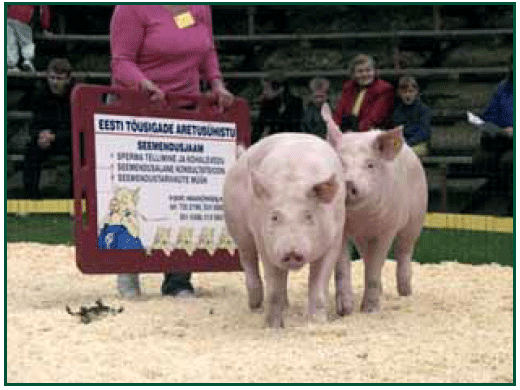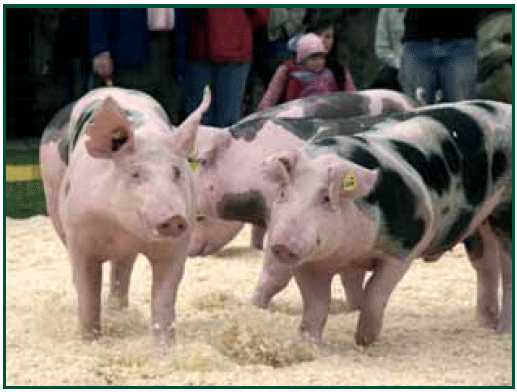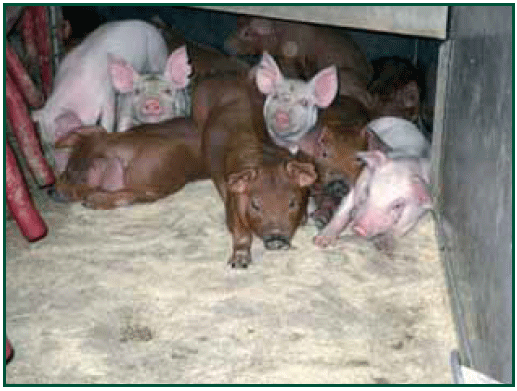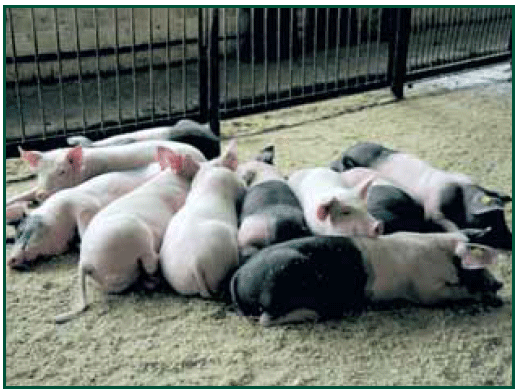



Estonia: Pig Breeding as a Tool to Serve Pork Production
In a report entitled 'Animal Breeding in Estonia 2004–2011' from Estonian Animal Breeding Association, Anne Lilleorg (Adviser to the Estonian Pig Breeding Association) explains the history of pig breeding in the country.In a market economy, pig breeding trends are reliant on
consumer demand. In a situation in which we have a number
of clients expressing different requests, we need to ask
ourselves: which consumer’s requests should serve as the
grounds for determining the trends of raising pigs in Estonia?
The meat processing industries are interested in uniform
carcasses with high lean meat content, which have as much
spinal muscle as possible, a thin layer of back fat plus large
hams. Regular consumers, however, would prefer the savoury
meat of pigs that have been raised in natural conditions, while
the price of such meat should also be acceptable. Pig breeders
appreciate the economic profitability in pigs – particularly, feed
conversion, growth speed and fertility.
Breeding trends are determined by solvent clients. In Estonia,
the meat processing industry is influencing pig farmers to
breed with lean meat content as high as possible, using the
SEUROP system to pay for the meat delivered. In 1995, the
base price of meat with 51 per cent lean meat content was the
starting platform; in 2004, the base price was raised to 57 per cent
lean meat content, where it has remained until 2011. A surplus
price is paid to pig breeders for lean meat content above the
basic level, while the price is deducted for carcasses with a
higher fat content. As the SEUROP system was launched,
the average lean meat content of batches of pork barely
reached the required 51 per cent level. The carcasses that are sold
today mostly belong to classes S and E and have 59 to 60 per cent
lean meat content.
How did pig breeders reach such results and what is the
situation for producers today?
Until the 1970s, mostly purebred pigs were raised in Estonia.
Estonian Landrace (L) pigs were common on the islands
and in western Estonia – phlegmatic, slender animals with
large floppy ears. In other parts of Estonia, pigs of a Estonian
Large White (Y) breed were bred – perky pigs with a short
body and cocked ears. The raising of purebred pigs was
facilitated by a practically bottomless market for breeding
pigs in the Soviet Union (up to 27,000 pigs with certificate of
parentage were sold every year) and state-owned breeding
stations were established for both breeds: the National
Breeding Centre for Large White Pigs (1948) and the National
Breeding Centre for Estonian Lop Eared Pigs (1951), which
was renamed as the State Breeding Centre for Estonian
Bacon Breed Pigs in 1961.
Research in the sphere of pig breeding confirmed the
presence of hybrid power in the first generation of
crossbreeds; this is shown by better daily weight gain and
better fertility rates. In pig breeding, the crossing of these
two breeds was heavily promoted in the 1980s. Such a
combination resulted in castrated pigs with good weight gain, yet carcasses with large fat content. Selling fatty pork was
not a problem in the huge markets of the Soviet Union. When
these markets disappeared, the lean meat content of pig
carcasses began to bring better pork prices.

(P. Kütt)

(A. Juus)
The pig breeders who had formed the Estonian Pig Breeding Association, started to develop a breeding programme for crossbred pigs (combinations of the four breeds), called 'Marble Pork', in 1995, which provided the pre-requisites for raising crossbred fattening pigs in Estonia. In 1995, the first sows and boars of the Hampshire (H) breed were imported from Sweden. In addition, the Pietrain (P) breed was imported from Austria in 1999. An extensive pig artificial insemination programme was launched and an artificial insemination station was established in Vasula, Tartu County, in 1997.

(P. Kütt)
A testing system for young pigs was launched in Estonia, following the example of Finland: the exterior of pigs was assessed and the PIGLOG-105 ultrasound equipment was used to measure the thickness of back fat and loin eye. Support from the PHARE programme was used to acquire a computer software db-Planer to record performance information; the software was later developed into the 'Possu' programme. A centralised system for the collection of centralised performance records facilitated the calculation of the performance and fertility values of pigs (Table 1).


(U. Märtson)
Unfortunately, high lean meat content works against the flavour of pork, turning it flat and giving it a stiff structure. The solution is to raise the intramuscular fat content. Pig breeders must find a way of hiding fat between bundles of muscles. The Duroc breed, which is widely used all around the world, and has many other good features, has such meat properties. The Duroc pigs are more stress resistant and their descendants have good fattening performance characteristics, combined with excellent growth rates, compared to other crossbreeds. The last characteristic is highly valued by pig breeders, who decided in favour of the Duroc pigs of Canadian origin (Table 2).

The meat technology and breeding specialist of the Estonian Pig Breeding Association, Aarne Põldvere, has assessed the carcasess of different crossbred pigs. Crossbred fattening pigs are differentiated by their different growth rates and the lean meat content of carcasses (Table 3). Pig breeders, who are aware of the preferences of consumers, can choose between the semen of boars of different breeds that are available from the artificial insemination station of the association.

History has a tendency to repeat itself. Today, pigs raised in
Estonia are reaching the Russian markets again: more than
a hundred thousand fattening pigs are sold abroad each year.
Indirectly, pig export volumes allow us to conclude that the
state subsidies for breeding – purchasing breeding stock –
and the strategy prepared by pig breeders have served their
purpose well.
Annual study tours to European companies that excelled in
the pig-breeding sector had an important influence. The first
pig-breeding farms visited were in Denmark (1995), followed
by study tours to Germany, Belgium, the Netherlands and
France. These tours helped to change the ways of thinking
of Estonian pig-breeders and expanded their horizons.

(R. Laanemaa)
January 2013








